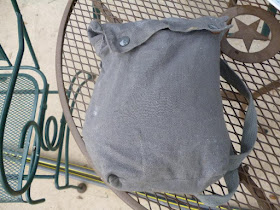Czech Model Z Gas Mask
The typical gas mask filter
uses a combination of three different techniques in order to treat the air you
are breathing. These techniques usually include particle filtration, chemical
absorption or adsorption and chemical reactions to neutralize chemical agents. The
most common filtration method used is by activated charcoal. The majority of gas
masks work by using a combination of activated charcoal to filter out organic
gasses and particles, super small filters used to trap smaller particles, and
various chemicals imbedded in pads to neutralize non-organic gasses and to
absorb and block the gas or gases while purifying the air.
NATO 40 mm Filter Cannister Top Seal
NATO 40 mm Filter Cannister Bottom Seal
Filters need to be replaced on
a regular basis because when they are exposed to humidity or have been unused
for long periods of time they lose their ability to absorb or block chemicals
and particulates. This in effect makes them non-functional and of little value
for NBC protection purposes.
Speech Diaphragm and Filter Connection
Many military surplus gas masks
are available in the $20 price range but most come with expired filters that
provide little more protection than the average dust mask. Shelf life of gas
mask filters can range from 5
to 25 years depending upon how they are packaged. Those gas mask filters which
have been vacuum-packed will have the best shelf life. Once they are exposed to
the air their useful shelf life is generally a matter of a few days before they
become ineffective. You will need to purchase new filters which will cost you
on average twice ($40) what you paid for the mil-surp gas mask.
Fog Prevention Vents
Depending upon the level of
contamination, gas masks will afford protection for as little as 30 or 45
minutes to as much as eight hours when concentrations are minimal. Gas masks
are basically designed to give you time to evacuate from the area in which
hazardous agents or chemicals are present. In order to work in a hazardous
environment, you would need an SCBA (Self Contained Breathing Apparatus)
similar to that used by First Responders or firefighters. This type of
equipment is extremely expensive (costing thousands of dollars) and is well
outside the budget of most people. New modern gas mask versions such as the M40
would make a good choice for some people wanting a more extensive level of
protection but this is also an expensive proposition with costs in the $400 to
$600 range.
Czech Model Z Carry Pouch
It is also important to remember
than many chemical agents are readily absorbed through the skin. A chemical
protection suit would be advisable for use in combination with your gas mask.
You would do well also to get some inexpensive chemical detection badges and
radiation dosimeters (these are fairly expensive) as well so that you will
actually know a threat exists or if the danger has passed.
Additional information about
gas masks and how they work can be found here:
Staying above
the water line!
Riverwalker







Also note - facial hair can compromise the effectiveness of a mask because it does not allow a tight seal between skin and mask material. So if threat or attack is imminent, be sure to shave.
ReplyDeleteThanks Riverwalker - I learned a lot from this post.
To; anonymous 12:09
ReplyDeleteIt's important to have no cracks or tears in the face mask portion, as this could compromise its effectiveness...
Excess facial hair, as you stated, could also prevent it from sealing effectively.
When I worked in hazardous gas environments in the oilfield, you weren't allowed to have any type of facial hair for obvious reasons.
We also used SBCA's but they only had a thirty minute air supply...usually sufficient to get you upwind from the threat if you moved fast enough.
Thanks anon.
RW